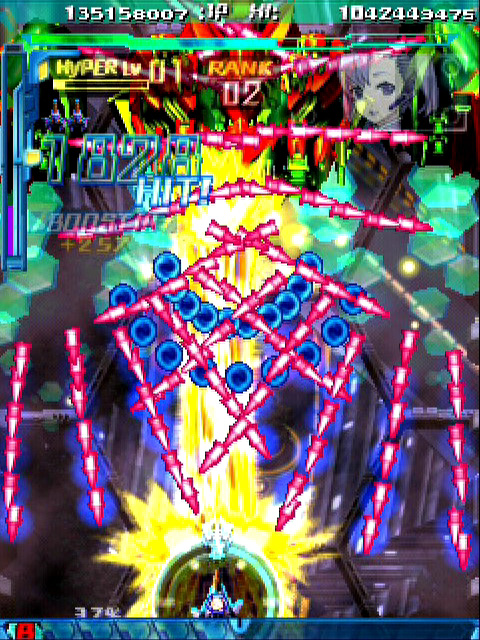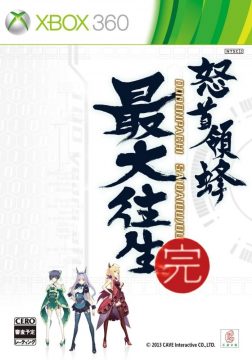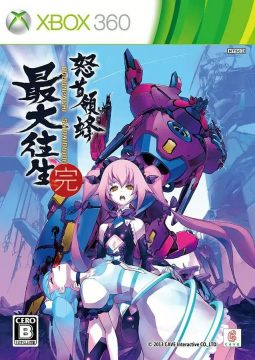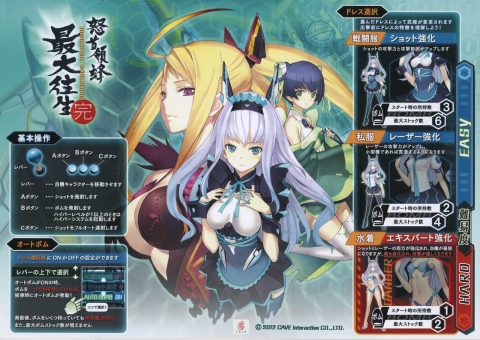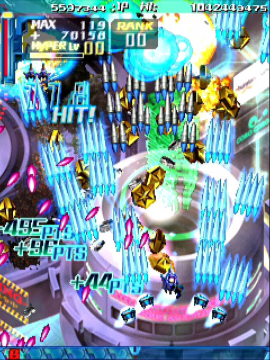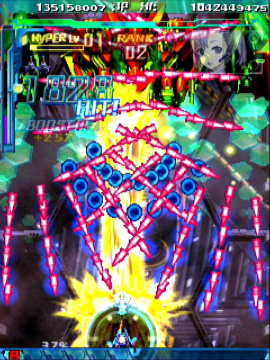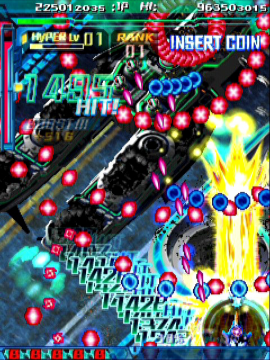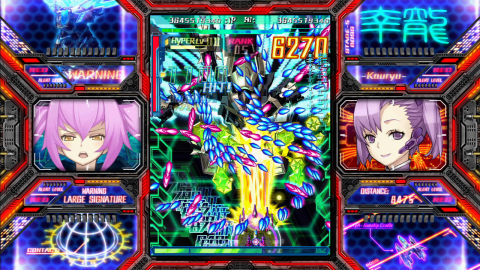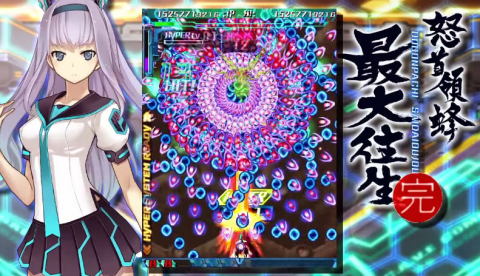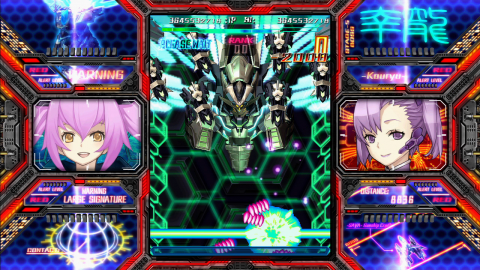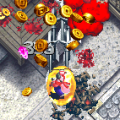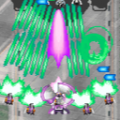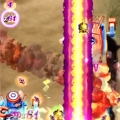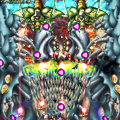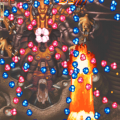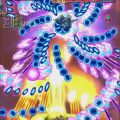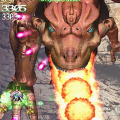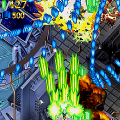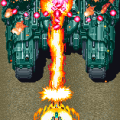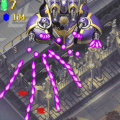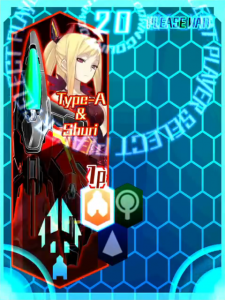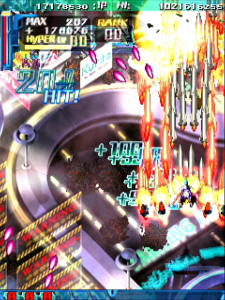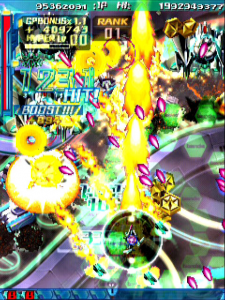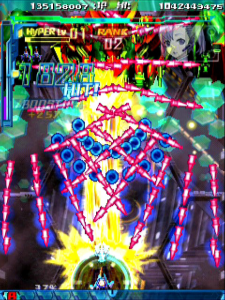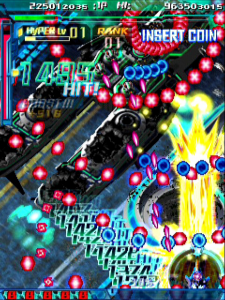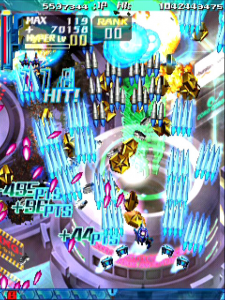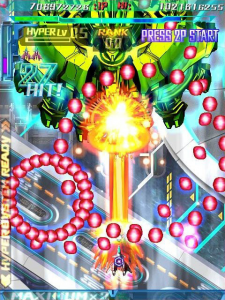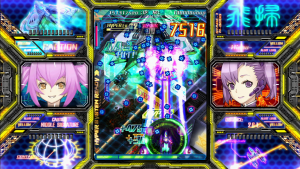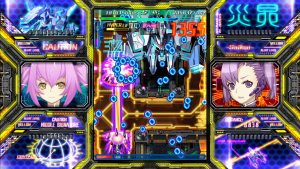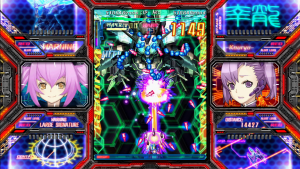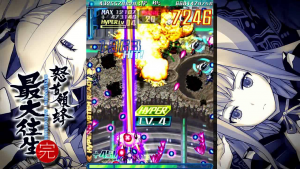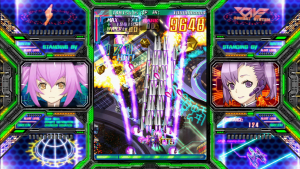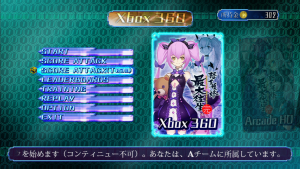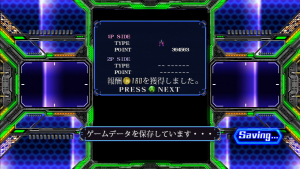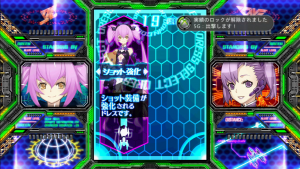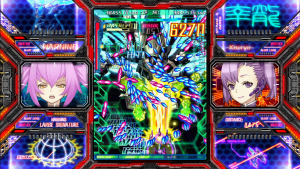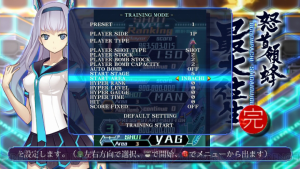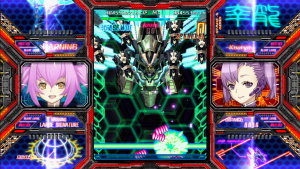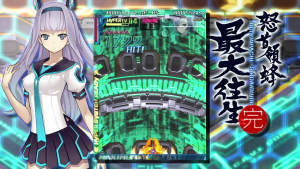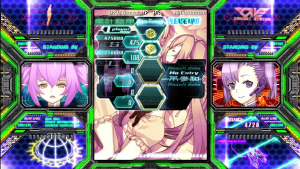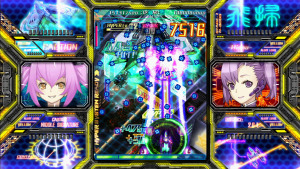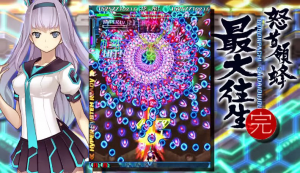A “Blissful Death” for 2012!
During the development of Dodonpachi MAXIMUM, Cave announced that they would release one more game for the arcades. One final release into the dying hardcore arcade shmup market. The game would be the final game for Cave’s CV-1000 hardware, and would be called Dodonpachi Saidaioujou (lit. “A Most Blissful Deat”h). The title is very important, as the game is just that: Daioujou in a (slightly different) parallel world. There are numerous homages to other games in the series, especially Daioujou. Note, that the kanji (完) inside the red circle stands for is known as “kan”, and usually means “complete”, but it can also mean “end”. However, despite its presence on the cover, Cave’s official website refers to the game as Saidaioujou, which is what this article will use when referring to the game.
Dodonpachi Daifukkatsu was a great release, but featured a complex bullet canceling mechanic that took some time to fully learn the system’s intricacies. With this next release, Director Tsuneki Ikeda wanted players to experience the simple joy of shooting and dodging. Ikeda entrusted Koizumi Daisuke, who was previously working on MAXIMUM, to come up with a gameplay system that was “simple, but interesting.” What Koizumi came up with was a “Daioujou for 2012″; a game that took the strengths of Daioujou and updated it for the play style of today’s world. The resulting game is one of Cave’s hardest games to date, featuring a high difficulty from the onset, fast bullets with very little slowdown, and very few ways to cancel them.
Story
Saidaioujou throws the player into the very beginning of a war. The player doesn’t know what’s going on, where they are, or what they are fighting for inside the game. There is however, a backstory to the current situation, which explains most of what is going on. There exists a city called the “City of Ideal”, where people were able to live peacefully in harmony with nature. This was due to the computer system located in the deepest part of the city. The computer was controlled by Old Element Doll Extra Z-001, codename: Hibachi. Hibachi’s purpose was to help humanity as much as possible. However, one day Hibachi decided that the best way to save mankind was to force them to “adopt a better form”. This caused her to forcibly “upgrade” everyone in the city into mechanized life forms. And, since Hibachi’s mission is to help all of humanity, she then set out to transform the Humans on Earth.
Meanwhile, mankind quickly recreates the legendary Donpachi Corps. of old, hoping that a select few of humanities best will triumph over the incoming enemy onslaught. Their mission is to attack and destroy the central computer system located in the City of Ideal. However, these pilots won’t be alone, as their ships will be equipped with the latest onboard assistant A.I., the “Element Doll”, greatly increasing the combat potential of the ship and pilot. The pilots are instructed to become fully rested, for when they wake up, mankind will be at war.
Characters
Element Doll Extra A “Shuri”
Shuri is the Element Doll for the Type-A ship. Her wardrobe features the color red, and consists of a lovely ballgown, a white labcoat and glasses, and a very risque swimsuit that shows off her bust. Shuri has a very aggressive personality and believes that the best defense is an even better offense. She enjoys history, and tradition.
Element Doll Extra B “Hikari”
Hikari is the Element Doll for the Type-B helicopter. Her wardrobe color is green, containing a flowing kimono, a breezy summer dress, and a one-piece swimsuit. She is a new model without much experience; as such, she is constantly referring to her pilot for his opinion and guidance. She likes dogs and samurai, but dislikes cats and indecision.
Element Doll Extra C “Maria”
Maria is the Element Doll for the Type-C ship. Her wardrobe is a features the color blue, with a futuristic maid outfit, a schoolgirl uniform, and a two-piece string bikini. Maria is incredibly quiet, but is always thinking of how she can help her pilot. She is able to analyze vast amounts of data and determine which course of action is best on the battlefield. She enjoys quietly looking at the waves of the ocean, or the flow of a river.
Old Element Doll Extra Z-001 “Hibachi”
An old model Element Doll, Hibachi was a prototype for the “Ultimate” Element Doll. She loves to smile, and has a very bright and cheery personality. She loved all living things, especially flowers. Her mission was to help humanity as much as possible, however she can. When she was with Saya, she always carried around a stuffed animal named Mad Bunny. After the experiment was discontinued, she was deactivated and frozen. One day, however, Hibachi suddenly reactivated was told to “Go save everyone.”, setting in motion the events of SaiDaiOuJou… She likes life, organisms, plants, and flowers in particular. She dislikes not making peace, and poison.
Element Doll Extra Z-002 “Saya”
A new character introduced in the Xbox 360 Story Mode. Saya was produced at the same time as Hibachi, and was developed as the “Ultimate” Element Doll. Saya is very precocious, always wanting to do her absolute best to help out and make her pilot smile, though she does refer to herself in the third person. She is the Element Doll for the Type-D ship, the most powerful ship to date. Her wardrobe color is purple, and consists of a cyber gothic-lolita style dress, an Akihabara Idol-like outfit, and her swimsuit is done in the kabocha pants style. Although she cherishes the time they spent together as sisters, she cannot forgive Hibachi’s sudden betrayal and her attacks upon their companions. She likes Mad Teddy and Mad Bunny, and dislikes Hibachi.
Pilot
The pilot (the player) was a member of the Air Force, before the best of the best in the world recreated the legendary Don Pachi Corps in an effort to combat the “mechanized enemies of the past.” Like the Donpachi of old, he will blindly follow the orders of the leader bee, without question or hesitation.
Gameplay
Since Saidaioujou was meant to be a simple game, the controls have been altered to reflect that decision, using only three buttons a-la Daioujou instead of four used in Daifukkatsu. The A button controls the Shot and Laser as usual, and the C button is mapped to rapid fire by default. The B button now controls the bomb and Hyper Mode, with the latter taking priority when filled. The biggest change in Saidaioujou is the elimination of any sort of loop system. That’s right, Saidaioujou consists of only a single loop, though Taisabachi and Hibachi return as the game’s final boss and secret bosses, the game’s real True Last Boss is Inbachi, an even more sinister version of Hibachi.
The standard Type-A, Type-B, and Type-C ships return for Saidaioujou, and act as they always have. The Type-A is fast with options that shoot straight ahead, the Type-C is slow its options shoot at a 45 degree angle, and the Type-B lies right in the middle with options that adjust as the player moves. However, the Type-B’s options adjust simultaneously, and adjust much faster than ever before. The options now reach their maximum angle as soon as the player moves in the left or right direction. After selecting their ship type (and its associated Element Doll), players then select what outfit the Element Doll will wear by moving the joystick to the left or right, and if Auto Bomb is on or off by moving the joystick up or down. The Dress System replaces the Style System from Daifukkatsu. The Dress System acts like the Type selection from Daioujou did. The default dress is the “Fighter” outfit, and it provides a boost to the ship’s Shot power. The next garment is their “Civilian” outfit, which gives the ship’s Laser a boost in strength. The final outfit is a swimsuit, which causes the ship to have the boosted Shot and Laser, but also sets the difficulty to “Expert”, Saidaioujou‘s equivalent to Mushihimesama Futari‘s Ultra Mode.
As stated before, players have the option of turning the Auto Bomb system on or off before the game begins. If Auto Bomb is on and the player has at least one bomb, rather than losing a life when hit, they will instead sacrifice their remaining bombs and stay alive. If the player does not have Auto Bomb enabled, or is out of bombs, the player will lose a life when hit. The Auto Bomb system is nice, but it comes at too high a cost to advanced players. In Saidaioujou, using a normal bomb no longer breaks the combo, instead only reducing it by 30%. However, if the player uses an Auto Bomb, their combo will be broken. The number of bombs a player can carry depends on what outfit they chose. The Shot Type starts with three bombs and can hold up to a maximum of six. The Laser Type starts with two bombs and can hold up to four, and the Expert Type starts with a single bomb, and can hold a maximum of two bombs at one time. Players can only increase the capacity of their bomb stock if they are playing without the Auto Bomb enabled, otherwise they are locked in to their default capacity. Otherwise, a player’s bomb stock will increase in capacity with each death, until it reaches it maximum. Note that if the player runs out of lives and has to continue, their bomb stock will be reset to its default capacity should they choose to continue playing. That said, even advanced players like to use the Auto Bomb feature, because it acts as a safety net. Advanced players are going to
Saidaioujou retains the Hyper Mode system found in Daioujou and Daifukkatsu, and works as a hybrid of the two. While active, the Hyper Mode augments the ship’s weaponry, causing them to gain a yellow hue, and transforming into wider and more powerful versions of the standard Shot and Laser weapons. Saidaioujou uses a Hyper Leveling system. Players start the game at Hyper Level zero. Things such as collecting bee or star items, or hitting enemies with the Laser Aura will cause the Hyper Gauge to increase. When the Hyper Gauge is full, it will increase the player’s current Hyper Level by one, up to a maximum of ten. Dying or activating Hyper Mode will reset the level back down to zero. Once the player has a Hyper Level of one or higher, the Hyper System will be available for use at any time by pressing the bomb button. Additionally, at Hyper Level one, the Operator or Element Doll will chime in and inform the player that the Hyper System is ready, the text “HYPER SYSTEM READY” will continuously flash on the left (Player 1) or right (Player 2) side of the screen, and a pod will appear behind the player displaying the current Hyper Level. Players will gain a brief period of invincibility upon Hyper Mode activation. At that time, any bullets onscreen will be outright canceled, and no further bullets will spawn until the invincibility wears off. Bullets are no longer canceled when the player exits Hyper Mode or gains a Hyper Level in Saidaioujou.
While Hyper Mode is active, the GP timer becomes twice as long as normal. In addition, the player will also receive a GP bonus multiplier and boosted HIT count, the values of which both depend on the level of the current Hyper. A level one Hyper only receives a multiplier of 1.1, increasing by .1 up to 1.5x at level five. At level six, the player’s Hyper itself becomes stronger, gaining an even wider Shot and Laser than before. To reflect this increase in strength, level six has a multiplier value of 2.2, which increases by .2 until level ten, where it becomes a 3 times multiplier. Unlike Daifukkatsu, the duration of the Hyper does not change with repeated use, or at higher levels, so it really isn’t worth it to use a Hyper lower than level six. Of course, there are some drawbacks to using the Hyper System. Located upper middle section game screen is a window with the word RANK and two digits below it. That number represents the game’s current Rank value. The higher the Rank value, the more difficult the game becomes, with the highest possible Rank value being fifty. The Rank value will increase with each Hyper System activation, though exactly how much it increases depends on what level of Hyper was used. The lowest possible increase value is one point, and this value increases by one every two Hyper Levels. Meaning that a Level 1 or Level 2 Hyper will only increase the Rank value by one point, whereas a Level 9 or Level 10 Hyper will increase the Rank value by five points. Luckily there are ways to decrease the Rank as well. Using an Auto Bomb will decrease the current Rank by one, while manually bombing decreases the Rank by two. Losing a life will reduce the Rank by three points.
Item-wise, Saidaioujou is very similar to Daifukkatsu, having no Power-Up items, instead only having a “B” Bomb item usually found right before the boss. Collecting this item at a full bomb stock will put the player in MAXIMUM Mode. The MAXMIMUM Mode awards 2,222 points multiplied by the Bomb MAXIMUM Level every 3 frames for MAXIMUM Level 1, 2 frames for MAXIMUM Level 2, and 1 frame for MAXIMUM Level 3. It’s a nice bonus, but due to a scoring glitch in the original 1.0 release, it isn’t too much of a factor to the overall score. The hidden bee items are back, but they are only one color, and don’t flash. There are eight bee items in each stage, with the first one valued at 5,000 points. Each successive collected bee item on the same life is then worth twice as much as the last bee item. Successfully collecting every bee item in a stage (on the same life) will double the values of the bee items in the next stage, and collecting every bee item through Stage 4 will cause the first bee item in Stage 5 to be worth 80,000 points. Sadly this doesn’t mean much in the long run, but it is better than nothing. Collecting a bee item will also increase the Hyper Gauge by a certain amount, depending on the number of HITs in the current combo chain. For every 50 HITs, the bee item will award an additional 1% of Hyper, up to a maximum of 30%. Additionally, if a player collects every bee in a stage the final bee will award an extra 100% (a full Hyper Level) in addition to the standard Hyper Gauge increase.
In Saidaioujou, there are two types of star items, (aerial and land), with each type containing two different sizes, (large and small) for a total of four different star items. Each star type and size has its own unique base point value. The small aerial stars are worth 100 points, and the large aerial stars are worth 1,000 points, where the small and large land star items are worth 500 and 5,000 points, respectively. The current GP bonus is also added to the values of each star’s base value when collected, with the resulting value being added to the player’s score when collected. In Saidaioujou, star items are created by destroying enemies or from the bullets canceled by destroying bullet cancelling enemies. The size of the star item generated depends on the current GP timer. If the GP chain timer is full, a large star item will be created, otherwise, only a small star item will appear. This is most easily accomplished by destroying a small popcorn enemy at point-blank with the laser, and then navigating to the left or right to destroy the remaining enemies nearby at a full GP timer. What makes this technique even more effective is that activating the Laser causes all onscreen aerial star items to be sucked into the ship, even if the button is released. Note that if the Hyper Mode is active, star items do not add to the Hyper Gauge.
Even though Saidaioujou does not have a second loop, players can still face off against a hidden final boss fight if certain requirements are met. Players will always face off against Taisabachi, as it is the Stage 5 boss. But, if a player does not lose more than one life from Stage 1 through the Taisabachi fight, and they managed to collect every bee in at least three stages, they will face off against Hibachi after defeating Taisabachi. Fans and players of Cave’s games will recognize Hibachi’s shot patterns, as they are all from past Cave True Last Boss fights. It’s a difficult fight nonetheless, but it seems rather disappointing, as Hibachi always managed to one-up itself with each encounter. But then again, Hibachi isn’t Saidaioujou‘s True Last Boss, her evil side, “Inbachi,” is. To fight Inbachi, players must No Miss No Bomb the entire game, collect every bee item in every stage, and meet two additional requirements. For Shot/Laser types, players will need to defeat Taisabachi at Hyper Rank 30 or higher, and have a max HIT count of at least 30,000 HITs. For Expert players, they need to be at Rank 40 or higher, and have at least 50,000 HITs. Not an easy task by any means, and the fight is a brutal struggle that will more than likely end a player’s game.
Scoring
Saidaioujou employs the same GPS (Get Point System) as the previous DonPachi games. Using the Laser weapon no longer causes the GP meter to decrease and then stall at a low value, but will instead actively increase the GP meter. Chaining in Saidaioujou is much easier than in previous DonPachi games. Now, having the GP timer reach zero no longer breaks the current combo, instead only cutting it by 25%, and then cause it to reduce at very fast rate until it hits zero. Whereas in previous games having the timer hit zero or bombing would instantly break the current chain.
In Saidaioujou destroying a bullet-canceling enemy will cause it’s on screen bullets to become star items. If the player destroys this enemy with a full GP timer, it will spawn large star items. It is that point that allows the “Hyper Recharge technique” to work, as the player’s GP timer is refilled upon exiting Hyper Mode. So, if a player manages to destroy a bullet canceling enemy such as a midboss as it uses a dense bullet pattern just as they exit Hyper Mode, all those bullets will become large star items, and since the player is not in Hyper Mode, the star items will increase the player’s Hyper Gauge. It’s an advanced technique that requires precise timing, but it becomes essential when playing for score. Remember, the most important part of performing a Hyper Recharge is when the Hyper System is activated. Sometime after the games release, a player managed to do one of the worst things possible in a score-based game: he broke the scoring system. When the GP counter exceeds 21,474,836, it actually causes the score counter to freak overflows the score counter’s value, setting it at a very high value that would otherwise be impossible to reach. This allows players to gain hundreds of millions of points in mere seconds. This glitch would go on to be known as the “overflow glitch.” The overflow glitch is a very advanced technique, requiring multiple Hyper Recharges to be pulled off in succession with very little room for error. Basically, there is no reason to ever not go for the overflow glitch. It is most often used in Stage 5 after the midboss rush, but it can be triggered as early as Stage 3 (though it basically requires a near-perfect run).
Above all else, scoring in Saidaioujou involves survival until Stage 5, at which point it then becomes about activating the overflow glitch. Until players can get that down, nothing else really matters, unless they are playing the patched Xbox 360 version with the glitch removed, as then, scoring involves a quite a bit more. For starters, try to not trigger the Auto Bomb, as it will immediately cause the chain to break. Do not be afraid to use a regular bomb if things get dicey. That said, try to let things get dicey or run out of enemies to shoot, as letting the GP meter run out or using a manual bomb will cause the current HIT count and GP bonus to be reduced by 25%. As for Hypers, unless they are going to do a Hyper Recharge, players will want to wait until they have a Level 6 Hyper for the 2.2 GP Bonus it provides.
Xbox 360 Port
Originally, Cave wasn’t officially planning on developing or releasing an Xbox 360 port of Saidaioujou at all, originally stating the last one would be Mushihimesama HD. So what happened that caused Cave to later retract this statement, going on to develop and release a port of Saidaioujou for the Xbox 360 a year later? The short answer is to never underestimate the power of a good drinking buddy. Producer Makoto Asada was approached by Microsoft, personally asking him (and Cave) to port Saidaioujou to the Xbox 360. In an interview, Asada revealed that he thinks the whole ordeal was a result of his weekly drinking sessions with a representative from Microsoft. The port was released May 30, 2013, after missing its initial estimated date for August 2012.
Xbox 360 Port and Features
The original arcade version of Dodonpachi Saidaioujou is a very pretty game, but because it’s running on a modified version of Cave’s SH3 hardware, it still ran at a 240 x 320 resolution with a 15 KHz refresh rate. Or in laymen terms: not HD. Because the reason the game wasn’t in HD was due to now inferior hardware, Cave usually took advantage of the Xbox 360’s power, redrawing every sprite to bring the game into glorious HD. For Saidaioujou, this meant taking an already gorgeous and shiny looking game and making it even prettier, and this release does not disappoint. The Xbox 360 port of Saidaioujou was released in three different editions: a Regular Edition, featuring only the game itself; a Limited Edition, which came in an oversized box and featured the game, an Arrange CD, and a special hardcover art book featuring exclusive interviews from the development team. Finally, there was the Super Limited Edition, which came in an even larger oversized box, and contained the Limited Edition version in addition to some stickers, an instruction sheet modeled after the one that is included with the PCB, and an exclusive Arrange soundtrack (different from the Limited Edition version). However, all versions contained the same game and game content, and most importantly, are Region Free!
The Xbox 360 port of Saidaioujou would feature a total of four unique gameplay modes: Arcade HD, Version 1.5, Novice, and a brand new Xbox 360 Mode. In addition to the four gameplay modes, there is a new Store option, allowing players to use coins gained from playing the game to unlock extra features and characters. Finally, there is the Gallery option, where players can view the pictures and sounds they purchased from the Store. While each gameplay mode has its own quirks in terms of gameplay, the options for each mode are pretty universal, but also tied to that specific game. Each game has an online leaderboard, but to view Arcade HD’s leaderboard, players must select the Leaderboards option from the Arcade HD menu option. There is of course a standard “arcade mode” where players can credit-feed through the game. Players are able to save replays in this mode provided they do not restart a stage. A Score Attack Mode, where players cannot continue if they run out of lives, but they can save and upload replays and scores to the global leaderboards. There is another Score Attack Mode, called Score Attack (Team), but as of writing, it is no longer operational, as it was a special contest (now ended) for a limited number of people. Each gameplay mode in Saidaioujou also has an accompanying training mode. Sadly Saidaioujou‘s training modes don’t come close to Dodonpachi Daifukkatsu‘s training modes. Daifukkatsu‘s training mode was great, offering many different options that allowed players to easily recreate almost any situation, down to the current score. Unfortunately, Saidaioujou‘s training modes offer little customization outside of a stage select and where to being the stage from. Players have no control over the number of bees collected, number of perfect bee collections from the previous stage, if they have lost a life or not, and very rigid parameters when it comes to the combo gauge. Still, the training mode is serviceable and can get the job done, but it’s nowhere near as easy or enjoyable as Daifukkatsu‘s.
An interesting addition to the Arcade HD Mode is the Challenge Mode. This mode contains 50 various challenges to complete within the Arcade HD Mode. These range from simply destroying the midboss of a stage without dying, successfully performing a Hyper Recharge after the Stage 1 midboss, or even beat a stage without ever dropping the chain combo. What’s neat about this mode is that players can watch a video of a super-player demonstrating one way to clear the challenge (similar to the “Super Guide” found in New Super Mario Bros. Wii). Successfully clearing a challenge also awards coins for use in the game’s Store. For some reason, only the Arcade HD mode has this Challenge Mode, which is a shame, as it would have been fun to have for every mode.
If a player receives a game over in any mode, they will also receive 20 coins for each successfully completed stage in that run. Players can also get coins by completing each of the 50 missions in Arcade HD mode. These coins are used in the Store option on the main menu. The Store sells a wide variety of goodies and extra features for use in the main gameplay modes. For example, Saidaioujou features very little wallpapers unlocked by default, requiring that players purchase additional wallpapers via the in game store. Other fun options such as making the ship smaller, automatic acquisition of items, displaying the bee items, disabling the operator, having the Player 2 ship piloted by a computer AI and even a “Full Auto” mode where the player ship’s movement and firing are done automatically can be purchased via the shop. The coolest (and most expensive) unlockable in the store is a whopping 3,000 coins, but allows players to use Saya and the Type-D ship in the other gameplay modes. Sadly, Saya and the Type-D acts like a normal ship, and doesn’t use the energy system from the Xbox 360 Mode (meaning that she also can’t use her ShotLaser in the other modes). Once she’s unlocked, she can be selected by pressing the Back button on the character select screen (the actual Back button, not the B / cancel button). There are also some extra sound tests for the character’s voices, but unless the player speaks Japanese, they aren’t important at all.
Xbox 360 Mode
Saidaioujou‘s Xbox 360 Mode was designed for the console market. Cave specifically wanted the game mode that felt distinct from an arcade game, ultimately deciding to focus on delivering a very story-heavy gameplay mode without disrupting the gameplay itself. To that end, Cave came up with a new original character and story set within the world of Saidaioujou. The Xbox 360 Mode sports a sleek new interface that takes advantage of the horizontal display and widescreen resolution of HD displays. The UI displays a visual representation of Saya on the left side of the screen, and the Operator on the right. The story in this mode is revealed to the player through conversations between Saya and the Operator throughout the game. The characters’ mouths move when they talk, and they have a number of different pictures to help convey their current emotions. It’s a nice touch, but boy, do they love to talk. Hardly a moment will go by without one of them talking, which may really turn some people off. For comparison, the arcade version of Saidaioujouhad 130 lines total. In the new Xbox 360 Mode, there are 450 for Saya alone! But, all of that means nothing unless the player can understand Japanese. Players can still form a general idea of the story based on character’s reactions and what happens onscreen, if they cannot understand Japanese, but a majority of the plot will ultimately be lost on them.
The arcade version of Saidaioujou was at its core, about seeing how far a player can get before losing all of their lives. This was why the game is so vicious, Hypers increase Rank, and bombs in that mode were so scarce, only offering a single bomb that was usually only available at the end of a stage. The Xbox 360 Mode, on the other hand, focuses less on survival and more on resource management of Saya’s energy, to be specific. The Xbox 360 Mode is single player only, and this allows Cave to use the upper right corner of the screen, which now hosts a large number in yellow text. This number represents Saya’s energy level, and starts at 10,000. If it hits 0, it’s Game Over; players only have one life in this mode. At the bottom of the screen is a new horizontal gauge. This gauge is represents the Saya’s energy just like the counter in the top right does, it just presents the information in a different manner. When the player goes below 2,000 points of energy, DANGER warnings begin to flash on the bottom and right sides of the screen, in addition to the counter itself. This is because the player does not have enough energy for an Auto Bomb, meaning one hit is Game Over. These warnings flash even faster when the player goes below 1,500, as the player now can no longer use a regular bomb. The garment system in this mode now also represents the game’s difficulty setting, as the Shot Type is also the easiest mode, with the Laser Type being noticeably harder, and the Expert Type being the hardest of the three.
This mode allows players to use the Shot and Laser weapons at the same time, similar to the system found in Daifukkatsu Black Label, and is performed the same way: by holding down the Shot (A) and Auto-Fire (C) buttons at the same time. In doing so, the player’s shot will transform into a powerful new weapon combining both the Shot and Laser weapons known as the… ShotLaser. Yes, that is its official name. Using the ShotLaser will drain Saya’s energy, but will cause destroyed enemies to generate Large aerial star items, even if they would otherwise only drop small star items, if any at all. The Xbox 360 Mode has Auto Bombing enabled, and there is no way to turn it off. Both manual Bombs and Auto Bombs cost energy to use. Manual Bombs reduce the energy counter by 1,500 points, and Auto Bombs reduce the counter by 2,000 points. Additionally, Auto Bombing causes the combo chain to break, but manually bombing only reduces it by 30%. So, despite having the safety net of the Auto Bomb, it is better to be proactive and manually bomb, than chance it and end up breaking the current combo chain.
In regards to the Energy meter, there three ways to drain it, but only one way to fill it: Hyper Mode. Specifically, it is the green star items that appear when attacking or destroying enemies in Hyper Mode. Attacking an enemy usually generates a small star item that recovers 5 points, destroying a small enemy creates a medium star item that recovers 7, and destroying a large enemy creates a large star item that recovers 16 points. When in Hyper Mode, players should stick to using the Laser, as it’s very powerful in this mode. In the Arcade HD Mode, the Laser increases the HIT counter by 1 every 21 frames, and that remains the same in the Xbox 360 Mode. Similarly, during a Level 1 Hyper in the Arcade HD Mode, the Laser adds 10 to the HIT counter every 20 frames, whereas in the Xbox 360 Mode, the Laser of a Level 1 Hyper raises the counter by 10 every 2 frames. Players should try and hold off on using a Hyper until they are at least Level 6. In addition to the increased GP and damage bonus, enemies will spawn large star items when destroyed at Level 6 or above, as opposed to the regular small ones.
Bee items do not increase the Hyper Gauge in the Xbox 360 Mode. Instead, players are awarded a number of points depending on their Ship Type multiplied by the MAX HIT value. Shot Type players will receive 1,000 points multiplied by the MAX HIT value when collecting a bee item. For Laser or Expert Type players, they will receive 10,000 points x MAX HIT value. Collecting every bee in a stage on the same life will cause the value of the final bee in the stage to be doubled.
Xbox 360 Mode Scoring
Playing for score in the Xbox 360 Mode can be really fun. Due to the nature of the system, players playing for score will be constantly hovering just outside of Danger Mode, having just enough for a bomb in case things get too dicey, and using high level Hypers to regain large amounts of health. Players will want to try to destroy everything with the ShotLaser, but especially try and destroy the small popcorn enemies with the ShotLaser, as this will cause them to generate large star items which will in turn award more Hyper Gauge. And because the ShotLaser takes energy to use, the process will eventually repeat itself until the player dies, or clears the game. It is important to note that it is possible to destroy individual parts of each boss. It is very important to do so, as destroying them gives around 25% to 50% Hyper Gauge depending on the part, making it very worthwhile to destroy all destroyable parts.
Version 1.5
During the development of the Xbox 360 port, Cave asked their play testers and super players what they were dissatisfied with in the original Saidaioujou, and what they could do to fix these issues for the Xbox 360 Mode. It turns out that the testers had an overwhelming number of complaints and ideas on how to make the game better, but not all of them fit the Xbox 360 Mode. It looked like most of their suggestions would end up unimplemented, but around that time, a programmer said that their changes were possible to implement as a new mode. The team then quickly got approval by the staff, and a new SaiDaiOuJou Version 1.5 was developed and completed before the new Xbox 360 Mode was finished!
Version 1.5 boasts a number of changes from Version 1.0. While this article will go over the most important changes, please see Developer Interview 1 in the link section below for a list containing all of the changes from Version 1.0 to Version 1.5. The aforementioned changes resulted in Version 1.5 being played at a much faster-pace and a higher scoring game than Version 1.0. While some of the original Version 1.0 strategies will still work in Version 1.5, there were enough changes to require a number of strategies to be changed or altered in some way. As for the changes, the most important one may just be that the “Overflow Glitch” from Version 1.0 has been fixed. Overall, Rank plays a larger role in the game, now affecting the MAXIMUM Bonus, the amount of Hyper Gauge received from star items. Star items are now worth less in Version 1.5, but are now affected by the GP bonus in addition to the value of their current HIT count multiplied by 10 being added to the total score value of the item. Collecting star items no longer reset the HIT counter timer interval of the Laser, but the Laser now raises the HIT counter at a much faster rate outside of Hyper Mode. The individual point value and combo gauge increase for enemies has been adjusted, in addition to the number of score items that appear when they are destroyed. The “No Miss” bonus at the end of each stage has also been increased.
The Hyper system has undergone some changes as well, with most of the changes affecting star items or Hyper Gauge, but there are a few notable changes to the Hyper Mode itself, especially when using a Level 0 – Level 5 Hyper. The GP bonus when using a Hyper has been increased for lower levels, as Level 0 now gives a GP bonus of 2.0, but the Hyper Mode only lasts half as long as a Level 6 or above Hyper, with each level lasting 10% longer and have a bonus worth .2% more. The Rank increase per Level remains the same as in Version 1.0. The Hyper Mode Laser has also been strengthened in this mode. The Laser now raises the combo gauge while Hypering in addition to coming out much faster overall, but the number of hits per frame has been reduced for all levels. All score items when performing a Level 6 Hyper or above will now always be the large version. When the Hyper Gauge is filled during a Hyper, the canceled bullets will now be large star items, instead of the small star items in Version 1.0. The amount of Hyper Gauge received from bee items has been adjusted. In Version 1.5, the amount of Hyper Gauge received is based on the HIT count of the current combo when the bee item is collected. Every 200 HITs will fill 1% of the Hyper Gauge, up to a maximum of 100% (20,000 HITs) per bee. Collecting every bee in a stage on the same life will also award an additional 100% of Hyper Gauge.
Version 1.5 Scoring
While most of the scoring basics from Version 1.0 are still present in Version 1.5, there are some significant key differences between the two. One of these key changes is the forced large star item spawn when using a Level 6 or higher Hyper. Because of this change, players can now perform the “Hyper Recharge” technique multiple times in each stage, usually resulting in a full Level 10 Hyper Recharge. Compare that to what it was like in Version 1.0, where it was only really feasible to perform a Hyper Recharge on the midbosses and very specific parts of Stage 5. And, since Level 6 and above Hypers now grant a GP bonus of 3.0 in Version 1.5, high level Hypers are now worth level more points than ever before. Therefore, performing an exact Level 10 Hyper Recharge is best for scoring in Version 1.5, with a few exceptions. When it comes to filling the Hyper Gauge in Version 1.5, there are two main ways to do so. The first is to damage enemies with the Laser Aura, and the second is by collecting the star items generated by destroying enemies when the chain timer is full. It is important to not rely on the bee items for Hyper Gauge in Version 1.5, but to instead view them as a supplement to the standard filling methods. To recap, scoring in Version 1.5 is all about using the Hyper Mode at Level 6 or above, maintaining a full chain timer as much as possible, and always executing a full Hyper Recharge when exiting the Hyper Mode.
Novice Mode
The Novice Mode in the Xbox 360 port of Saidaioujou is just like the other Novice Modes found in Cave’s other Xbox 360 ports. In Saidaioujou, the Novice Mode is based on the Arcade HD Mode, and features simpler bullet patterns, and less bullets overall. Scoring for the Novice Mode should therefore be just like the Arcade HD mode, but with some small changes with Hyper Recharges due to the decreased number of bullets.
Music
Saidaioujou‘s music was composed by Manabu Namiki of Basiscape. Namiki also composed the music for several Cave shoot-em-ups, such as Dodonpachi Daioujou and Dodonpachi Daifukkatsu. However, the intro song, “Stardust Void”, for the animated introduction on the Xbox 360 port was performed by Aya Hirano. Much like the game itself, the soundtrack for Saidaioujou features numerous references and callbacks to previous Dodonpachi games and tracks, even some of the Arrange albums. Take the character select track, “キザシ” or “Kizashi” for instance, which is clearly heavily influenced by the “Select” track on the Dodonpachi Daifukkatsu Arrange Album. The DonPachi series has always had an electro-influenced sound, but with Saidaioujou‘s visual style, this might just be Cave’s most electronica-based album to date. Tracks such as Stage 4’s “ヒビ” (Hibi) feature multiple sudden tempo changes and style shifts, something prominent in modern electro music. Then there’s “タイジ” (Taiji), which doesn’t drop the bass, but manages to throw in the “wub wub” sound associated with Dubstep for about 10 seconds before regaining composure and continuing on. “テンシ” (Tenshi), the True Final Boss track is super heavy industrial grunge. Starting off at an already blistering 260 BPM, the track eventually works its way up to 300 BPM making sure almost everything feels off beat before a brief crash back down to 230 BPM, after which it settles down around 272 BPM for the rest of the track. However, unlike previous incarnations of the True Last Boss track, it’s not very chaotic, not having much in terms of melody, and what is there being drowned out from the constantly driving backbeat. The driving backbeat was present in the Daioujou and Daifukkatsu iterations, but nowhere close to as overpowering as it is in Saidaioujou. That said, overall it’s hard to believe that Saidaioujou‘s OST is for a single game, and not for something like MAXIMUM which was comprised of several different games. There are just so many homages and melodies taken and remixed in Saidaioujou‘s soundtrack that it almost sounds like an arrange cd.
Final Thoughts on Saidaioujou
For the Arcade HD mode, playing for can survival can be quite a challenge, but entirely doable, especially after watching some replays and seeing how other people successfully beat the game. But if playing for score, in the original version, the game boils down to one single point: triggering the overflow glitch in Stage 5. If a player cannot (or does not want to) perform that glitch in the original version, there is no real reason to play that mode. Now, playing the patched version of the Arcade HD, which fixes the overflow glitch, things once again come down to honing and modifying the routes as per usual. The Xbox 360 Mode is really unlike anything else Cave has done. It’s clear that they knew they needed to try something new, and that’s just what they did. Creating a gameplay mode that takes advantage of the home console setup (16:9, and Yoko Mode) was a very smart move. The new gameplay system is fun, and can be quite a rush if playing for score, as players will usually be playing just outside of instant death range, often entering it only to quickly boost it back up via the Hyper Mode. Having players always fight Hibachi and Inbachi (with a more powerful ship) is great, and may just be the only way most players ever encounter either of them in standard play. Though not everyone will enjoy the constant talking between Saya and the Operator. Version 1.5 is a fun game for those who want a slightly remixed or updated version of Saidaioujou, or just find the original version of the game a bit too slow. Because of the changes to the Hyper System and the star items, Version 1.5 feels like a more fast-paced version of Saidaioujou. Version 1.5 has just enough changes to feel fresh, yet familiar, rather than foreign.
The game sold well enough to get a Platinum Collection re-release which is always good for shmup fans. Although the game never had a release outside of Japan, Cave was gracious enough to allow all versions of Saidaioujou to be Region Free, meaning that it can be played on any Xbox 360. As an added bonus, all players are connected to the same leaderboards and online functionality, allowing them to get the patched version of the game (which fixes some bugs and glitches), without any extra hassle. Although this release may not have as many gameplay modes as Daifukkatsu, the port is still very enjoyable and has a large amount of replay value. If nothing else, Dodonpachi Saidaioujou was one hell of a note to go out on.
Links:
SDOJ Official Site
Strategy Discussion A shmups.system11.org thread that details all modes of SDOJ
Detailed Mode Differences An excellent blog post about the core systems in the different modes
Archive.org cache of a Cave-STG thread Another strategy thread from the now defunct Cave-STG
Developer Interview 1 An interview that details Ver. 1.5 and the Xbox 360 Mode
Developer Interview 2 Previously only available via the Special Limited Edition version
SDOJ Arcade TranslationsA fan translation of SDOJ’s story and dialogue
SDOJ 360 Mode Translations A fan translation from the official website
Ending Translation A fan translation of the Arcade Mode Ending
STG Weekly #43 A highly insightful and very detailed look at SDOJ, contains NSFW language
SDOJ Ver. 1.5 Superplay Part of IcarusFW’s “Special Demonstrations” series, features great commentary
SDOJ OST YouTube Playlist Only the first 16 tracks are from SDOJ
SDOJ Arrange OST YouTube Playlist Only available with the Limited Edition Version
Closing
During the development of Saidaioujou, producer Makoto Asada joked that the series was supposed to end with Daioujou, but continued with Daifukkatsu and Saidaioujou, so there will probably be a “SaiDaiFukkatsu” too. For some fans, those words offered a very dim ray of hope for Cave’s future. At the time, the hardcore arcade shmup market in Japan was dying a slow, painful death. Despite their best efforts, Cave couldn’t revitalize the market and genre they created more than a decade ago. Despite seeing the writing on the wall, some fans still held out that Cave would somehow pull through, despite Cave ceasing operations of their online international, and then domestic store altogether, canceling numerous games and ports, even ceasing development on Saidaioujou for a time, and COO Tsuneki Ikeda stating multiple times that Saidaioujou may just be the last game Cave will ever make.
The release of Saidaioujou on the Xbox 360 was seemingly bittersweet, as the next day (May 31, 2013) Cave would announce that they are restructuring and refocusing their developmental efforts. This news, after Cave cancelling a number of unannounced projects in development, ultimately lead people to believe that Cave would no longer be making shmups. Although later information revealed that while there wasn’t any shmups planned or currently in development it’s not out of the question that they would make another one, things only got worse as key figure Makoto Asada left Cave not long after its restructuring announcement. Cave’s latest game, Don★Paccin was released for iOS and Android devices in Japan on November 27, 2013. Despite the similar-sounding title, there is very little connection to the DonPachi series, and as such it is not included in this series. Since Don★Paccin‘s release Cave has not released any information regarding new projects. In more recent news, Cave’s community manager MASA-KING announced that the English Cave-World Twitter and blog would shut down on February 28, 2014. This terminated any and all active English presence Cave had. As of time of writing, it’s very possible that we may never see another DonPachi game, let alone any new shmup from Cave. Although that may be the case, that doesn’t retroactively diminish the quality of the series. There’s a reason Dodonpachi cemented the Bullet Hell genre, and each subsequent release managed to test and push the limits of the humans who played them.
If nothing else, remember what the DonPachi series and Tsuneki Ikeda taught its players:
“Dying is good.”
